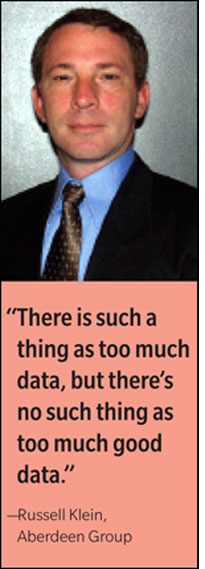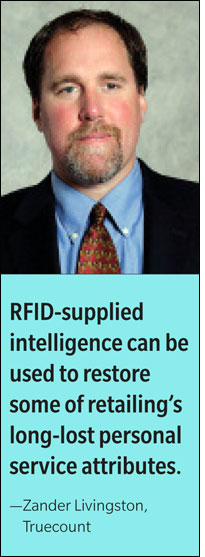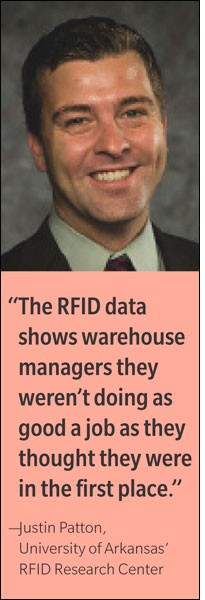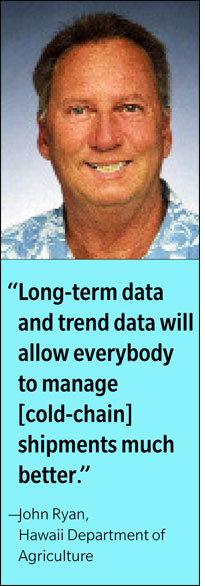Feb 01, 2011Most companies considering deployment of radio frequency identification systems today are focused on basic visibility: the "what," "when" and "where" of pallets, cases and items. But early adopters are learning that RFID also adds the "why" and "how" to the information pool, transforming the technology from a relatively simple tracking and tracing tool into a powerful knowledge-gathering resource. As RFID vendors and adopters continue to stretch the visibility envelope by designing and deploying ever more innovative systems, they're discovering the technology's value as an increasingly steady and reliable source of high-quality business data.
RFID's ability to deliver intelligence directly from the source is what makes it a particularly valuable knowledge-gathering tool, as well as a good investment. "There is such a thing as too much data, but there's no such thing as too much good data," says Russell Klein, a vice president at Boston-based Aberdeen Group, a technology market research firm. "You can spend $5 million upgrading your ERP [enterprise resource planning] system, but that doesn't give you better information."
Companies that fail to perceive the value of RFID business intelligence risk falling behind the competition, says John Ryan, administrator of the Hawaii Department of Agriculture's quality assurance division, which is evaluating whether RFID-generated environment intelligence can be used to optimize produce transport. "The ones that are successful and stay ahead of the game are the ones that don't wait for the hammer to come and hit them on the head," he says. "They're the ones who are curious about the technologies that are available."
There are two basic approaches to getting operational efficiency or better performance from RFID-driven business intelligence, Klein says. "One is to identify a problem, and then use the data to validate the problem and identify an opportunity for optimization in the business process," he says. "The other is to approach the data without a preconceived notion of what you hope to find, and discover opportunities for improvement."
Today, enterprises across a wide array of sectors, including manufacturing, retail and health care, are adopting one or both approaches, employing RFID's ability to deliver actionable knowledge and insight into complex situations.
RFID goes beyond simply letting users view an object's location at any given moment. "Creating actionable data about items in your supply chain allows you to be smarter about how you're managing that material as it's moving from, say, the OEM [original equipment manufacturer] to the end user," says Mary Ann Wagner, president and CEO of XIO Strategies, a supply-chain management company based in Vienna, Va.
Wagner says actionable data also can help companies get fast answers to critical business questions, such as: "What's the lead time? What's the cycle time on that manufacturing process? How long will it take from the time we cut a procurement order until the item is ready for delivery? What do our demand cycles look like? What's our forecast and how accurate is it?"
Among all identification technologies, only RFID allows quality data to be collected automatically and efficiently without impeding vital supply-chain operations. "If you're moving large volumes of freight, you don't want to stand in the choke points and do a one-to-one read of that material as it's moving through those choke points," Wagner says. "You really want to do it in volume, and that requires hands-free data capture."
Many manufacturers are reluctant to share their RFID-supported inside knowledge for competitive reasons. Greater knowledge typically leads to more efficiencies and higher profit margins, says Andy Mullins, CEO of Atlanta-based Precyse Technologies, which supplies visibility-oriented RFID systems to manufacturers. RFID technology has a unique ability to provide real-time insight, which lets them analyze a wide range of production and inventory applications, he adds. "If you know what you have in inventory, and where you are in the build cycle... schedulers can see this and know they need to adjust their upcoming orders," he says. "If you can reduce inventory level, your value as a company goes up."
One customer, which Mullins declines to name, uses RFID to track its parts inventory in real time. "By having this information, they know if they can start manufacturing and get things done," he says.
Apparel retailers that have adopted RFID to better manage complex inventories are discovering that data generated from item tracking also can be used to analyze what, when and where customers are buying. That, in turn, enables retailers to study customer trends in pricing, size, color, popularity and co-purchases, so they can understand why some products sell better than others, and how to increase sales.
"Beyond an inventory-management piece, there are lots of little ancillary benefits you can get with RFID," says Zander Livingston, CEO of Truecount, a company headquartered in East Dorset, Vt., that develops retail-focused RFID software. "The ability to track customer behavior, how many times an item comes off a rack and then gets placed back on a rack—this type of information becomes available now because RFID is the best way we've ever discovered to count items fast and accurately," says Livingston, who led American Apparel's pioneering RFID efforts.
RFID-generated intelligence can deliver actionable data on a host of critical issues, including inventory levels, stock locations and missing or potentially stolen products, Livingston notes. But perhaps RFID's most insightful application lies in its ability to deliver bursts of customercentric knowledge: "What are the behaviors of my customers? What are they looking at? What are they bringing to the fitting rooms? What sells and what doesn't sell? Conversion metrics on products," he says.
RFID-supplied intelligence can be used to restore some of retailing's long-lost personal service attributes, Livingston says. It gives sales clerks instant, on-the-floor insights into each customer's likes, dislikes and needs. "It's going back to what it was in the old days," he says. "Think about retail way back when. It was a very personal experience, and what we're allowing with this data intelligence... is to now apply some of that personal touch again."
Positioned in the middle of the supply chain, warehouse operators might appear to have little need for RFID-generated intelligence. Yet modern warehouses are far removed from the simple storage facilities of bygone days. In today's high-volume, just-in-time logistics environment, warehouses function as both storage centers and product-management stations. Modern warehouses are expected to share inventory, flow-through, capacity and other types of strategic intelligence with makers, sellers and shippers.
Many organizations only believe they understand their inventory processes, says Justin Patton, RFID lab director at the University of Arkansas' RFID Research Center, in Fayetteville. "They think their warehouse management is very accurate," he says. "They think they have a good handle on their product-in, product-out shipping and receiving processes." Yet as soon as they begin studying cold, hard RFID-generated data about their operations, most quickly realize there are many areas ripe for improvement. "The RFID data shows warehouse managers they weren't doing as good a job as they thought they were in the first place," Patton says.
In addition to helping warehouse operators improve efficiencies, RFID technology can help them manage specialized stock, which requires a way to separate inventory into individual, fully monitored categories. Singapore-based Wilmar International, the largest global processor and merchandiser of palm and lauric oils, uses an RFID system developed by RedBite Solutions, based in Cambridge, England, to identify and track its various cooking oils.
Some of Wilmar's oil products must be stored in areas that maintain specific temperatures. "RFID can be used to accurately control the quality of our oil," says Ah Yong Ong, Wilmar's group technical manager. "RFID captures the date and time for each pallet of oil when it is added," he says. "The system then tracks each pallet's time in the refrigerated area, allowing our forklift operators to determine which containers of oil are ready to be shipped at which time."
RFID systems also can create other types of operational knowledge, such as enabling managers to view and compare stock levels and delivery rates of individual facilities, says Alex C. Y. Wong, RedBite's CEO and cofounder. "You can quickly learn from the safety stock, for example, if someone is holding too much or too little," he notes.
While cold-chain players initially adopted RFID to track the delivery progress of perishable items, the technology has been enhanced to allow continuous monitoring of temperature, humidity and other environmental conditions that could impact product quality. RFID can provide a reliable stream of actionable information, says Peter Mehring, CEO of Intelleflex, a cold-chain RFID systems vendor in Santa Clara, Calif. Users with particularly critical knowledge needs can elect to add real-time monitor and alert functions to their shipments, he notes.
"By augmenting the RFID data with summary data showing the condition of the produce, we can tell you how many days of shelf life the produce has, so you can reprioritize it with other pallets in the same shipment," Mehring says. "The business intelligence relating to the data capture... adds significant value both tactically and strategically for our customers."
Knowledge-rich RFID services have arrived at just the right time, says Ryan, the Hawaii Department of Agriculture's administrator. The food industry is in dire need of deeper and more meaningful intelligence as more food products are transported along the cold chain from producer to wholesaler to retailer, he adds. "There's currently no measurement of whether or not there's bacteria on the food... or anything like that," Ryan says. "Long-term data and trend data will allow everybody to manage shipments much better. and to establish what the limits ought to be."
Improving Patient Care
Asset tracking has been helping health-care organizations, from medical centers to clinics and long-term care facilities, reduce costs and ensure higher-quality, more efficient service. By analyzing RFID-generated data, for example, Texas Health Presbyterian Hospital, in Dallas, has been able to get a better handle on its mobile and portable equipment, improving inventory management and cutting rental costs. Although the hospital owns most of the equipment it uses routinely, in the past it frequently found itself forced to rent items to cope with temporary needs.
RFID-generated data also helped the hospital conduct time and motion studies that ultimately yielded significant cost savings. "Before the RFID system, nurses were spending 13 minutes, on average, looking for equipment each time they needed it," Abernathy says. "Now, with the system, when they search for it, they're able to get the equipment almost immediately, because they can see exactly where it is and pick it up."
Furthermore, by closely studying trends, the hospital now can anticipate needs rather than react to them. "For instance, we now know that we need more bariatric beds," Abernathy says, referring to beds required by morbidly obese patients. "We didn't have enough of these; that was some more business intelligence we acquired."
Pharmaceutical manufacturers are discovering that RFID technology is the ideal prescription for their business-intelligence needs. A growing number of industry players are using RFID to detect and remove dangerous counterfeit products. "They're making sure that duplicate serial numbers, and numbers that have never been commissioned, aren't being introduced into the system," says Perry L. Fri, senior VP of industry relations, membership and education, for the Healthcare Distribution Management Association, a pharmaceutical trade organization headquartered in Arlington, Va. "One way of doing this is by understanding where products are moving in the system, and then making sure they're not disappearing out of—or miraculously reappearing into—the system."
RFID intelligence is invaluable for protecting the global pharmaceutical market, according to Fri. "What we're trying to do is make sure the authentic product is moving from the manufacturer to the distributor and on to the pharmacy, and that makes it ultimately safer for the patient," he says.
Government bodies of all kinds and at all levels have long used intelligence for a wide range of purposes, from public works to national security. For such organizations, RFID is another useful tool in an already powerful arsenal of fact-collection technologies and processes. Many government agencies use RFID-generated intelligence in the same way businesses do: to support various types of production and transportation services, and to manage inventories.
Westminster City Libraries, for example, which operates more than a dozen libraries in the heart of London, has RFID-tagged its entire lending collection and installed self-service checkout machines, to reduce customer queues, increase public space and free staff to support customers where they need it most. "The staff... can talk to people and deal with them, rather than sort of hiding behind a huge counter just stamping books," says Catherine Cooke; senior business systems analyst for Westminster City Libraries.
While customer convenience is a high priority for Westminster, the RFID system also helps administrators by generating actionable data that improves book inventory organization and management. Westminster can locate books distributed throughout the library system, which lowers costs and improves customer satisfaction, Cooke says.
Boosting the Bottom Line
In the years ahead, business-intelligence generation and analysis is destined to become a top priority for RFID vendors and customers, says Aberdeen Group's Klein. "Most companies recognize that the greatest potential value of item-level tagging—RFID-enabled visibility—is in the data that's produced," he says. "In one form or another, they will all be looking at the data."
Recognition of RFID's formidable intelligence-gathering capabilities is already leading to a generation of software applications designed to help enterprises squeeze decision-support knowledge out of retrieved data. "We're seeing a new category of software-solutions companies and service providers emerging that focus entirely on building business-based rules for data governance, to determine which data is valuable and which isn't, how to store it in the data warehouse, how long to keep it and who to alert if certain conditions are met indicating a situation that requires immediate attention," Klein says.
RFID's ultimate value as a knowledge resource, regardless of the way it's used, lies in its ability to add to the bottom line, says XIO Strategies' Wagner. "There isn't an organization that's going to do this just because they think it's interesting," she says. "Organizations are looking to take costs out of their operations."






